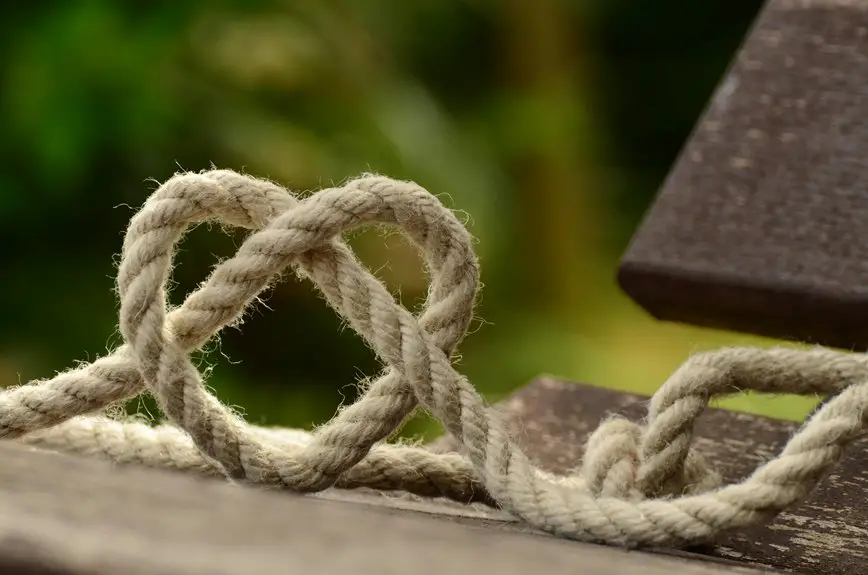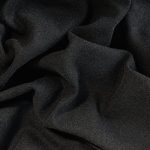Yes, you can iron jute fabric safely by using a low or medium heat setting and avoiding steam, which can damage the fibers. Always iron on the reverse side and place a pressing cloth between the iron and fabric to prevent scorching. Keep the iron moving to avoid leaving marks, and test a small area first. Handling your jute carefully helps maintain its texture and durability. If you want to keep your jute looking great, there’s more helpful advice ahead.
Table of Contents
Key Takeaways
- Yes, jute fabric can be ironed but only on low to medium heat to prevent scorching or burning the fibers.
- Always iron jute on the reverse side using a pressing cloth to protect the fabric from direct heat damage.
- Avoid using steam or excessive moisture as it can weaken jute fibers and cause warping or distortion.
- Keep the iron moving continuously and never leave it in one spot to avoid heat damage.
- Test a small hidden area first and allow the fabric to dry completely before ironing for best results.
Understanding Jute Fabric and Its Properties
Jute fabric, known for its natural texture and eco-friendly qualities, is a popular choice for various uses. When you work with jute, you’ll notice it’s a strong, coarse fiber derived from plants. Its durability makes it ideal for bags, rugs, and home decor.
You’ll appreciate that jute is breathable and biodegradable, which contributes to its environmental appeal. However, jute isn’t as flexible or smooth as cotton or silk, so it wrinkles more easily and can feel rough against your skin.
Understanding these properties helps you handle jute properly, especially when cleaning or ironing. Since jute fibers are sensitive to heat and moisture, knowing its nature guarantees you treat the fabric carefully to maintain its look and longevity.
Why Ironing Jute Requires Special Care
When you iron jute, you need to be careful because it’s sensitive to heat and can scorch easily.
Adding too much moisture can weaken the fibers and cause damage.
If you’re not cautious, you risk ruining the fabric’s texture and appearance.
Heat Sensitivity of Jute
Although it may seem straightforward, ironing requires special care with jute because the fibers are highly sensitive to heat. When you apply too much heat, the natural fibers can scorch, weaken, or even burn, leaving permanent damage.
You need to keep your iron on a low setting to protect the integrity of the fabric. Avoid using steam directly, as it can cause unexpected reactions with heat on jute’s rough texture. Instead, use a pressing cloth between the iron and fabric to distribute heat evenly and prevent direct contact.
Moisture Impact on Fibers
Since moisture interacts uniquely with natural fibers, you need to handle jute carefully during ironing to avoid damage.
Jute fibers absorb water readily, which can cause swelling and weaken the fabric’s structure temporarily. When you apply steam or dampen jute before ironing, the moisture softens the fibers, making them more pliable but also more vulnerable. If you use too much moisture, the fabric can distort or develop uneven textures.
On the other hand, ironing jute completely dry might lead to stiffness or permanent creases. To maintain the fabric’s integrity, use a light mist of water or a low-steam setting, and always test on a small area first.
This careful balance helps you smooth wrinkles without compromising jute’s natural strength and appearance.
Risk of Fabric Damage
Because jute fibers are coarse and loosely woven, ironing without proper care can easily cause permanent damage.
You need to handle jute fabric gently to avoid crushing the texture or causing burns. Applying too much heat or pressure can weaken the fibers, leading to fraying or holes. Additionally, moisture levels must be controlled to prevent distortion or shrinkage.
Here’s why ironing jute requires special care:
- Excess heat can scorch or discolor the fabric.
- Heavy pressure flattens the natural texture.
- Too much steam weakens the fiber structure.
- Direct contact with the iron can leave shiny marks.
Preparing Your Jute Fabric for Ironing
Before you start ironing, make sure your jute fabric is clean to avoid setting any dirt permanently.
Always test a small patch first to see how the fabric reacts to heat.
Then, adjust your iron to the appropriate low heat setting to protect the fibers.
Check Fabric Cleanliness
Although ironing can freshen up your jute fabric, you’ll want to make sure it’s clean first.
Dirt, dust, or stains can set permanently when heated, ruining the fabric. Before you start, check for any visible marks and remove them properly.
Here’s what you should do:
- Shake the jute fabric outdoors to remove loose dirt and dust.
- Spot-clean any stains using a mild detergent and cold water.
- Allow the fabric to dry completely to avoid steam damage during ironing.
- Avoid using harsh chemicals that could weaken the fibers.
Test a Fabric Patch
Try ironing a small, inconspicuous patch of your jute fabric first to check how it reacts to heat. This simple test helps you avoid damaging the entire piece.
Choose an area like a hem or inside corner where any changes won’t be noticeable. Place a thin cloth between the iron and the fabric to protect the fibers.
Press the iron gently for just a few seconds and then lift it—don’t slide it over the fabric. Check for any discoloration, scorching, or texture changes.
If the patch looks good, you’re ready to proceed with ironing the rest of the fabric carefully. If not, reconsider your method or adjust your approach to prevent ruining your jute fabric.
Testing a patch is a smart step to guarantee safe ironing.
Use Appropriate Heat Setting
When you prepare to iron your jute fabric, selecting the right heat setting is crucial to prevent damage. Jute is a natural fiber that can scorch or weaken under high temperatures. To keep it safe, always start with the lowest heat setting on your iron. Gradually increase the heat only if wrinkles don’t smooth out.
Here’s how to use the appropriate heat setting:
- Set your iron to the “low” or “synthetic” setting.
- Avoid using the “cotton” or “linen” settings, which are too hot.
- Use a pressing cloth between the iron and jute to distribute heat evenly.
- Test the heat on a small, hidden patch before ironing the entire piece.
This approach guarantees your jute stays intact and looking great.
Choosing the Right Iron Settings for Jute
Since jute is a natural fiber with a coarse texture, you’ll need to adjust your iron settings carefully to avoid damaging the fabric.
Start by setting your iron to a low or medium temperature, typically the “cotton” or “linen” setting works well. Avoid high heat, as it can scorch or weaken jute fibers.
Use the steam function sparingly or turn it off completely, since excess moisture may cause the fabric to warp. If your iron has a synthetic or delicate setting, that can also be a safe choice.
Always test your chosen setting on a small, hidden area of the fabric first to make sure it doesn’t cause discoloration or damage.
Proper settings help you smooth wrinkles effectively without risking harm to your jute fabric.
Step-by-Step Guide to Ironing Jute Fabric Safely
Adjusting your iron settings properly sets the stage for safely ironing jute fabric.
Once your iron is on the correct low heat setting, follow these steps to protect the texture and fibers of your jute:
- Lay the jute fabric flat on a hard, heat-resistant surface.
- Keep the iron moving continuously to avoid scorching.
- Avoid using steam, as moisture can weaken jute fibers.
- Iron the fabric on the reverse side to minimize direct heat exposure.
Using a Pressing Cloth to Protect Jute
Although jute is a sturdy fabric, you’ll want to use a pressing cloth to shield it from direct heat while ironing. This extra layer prevents scorch marks and keeps the fibers intact. Using a clean, damp cotton cloth works best. Simply place it over the jute, then press the iron gently without steam. This method protects your fabric and prolongs its life.
| Step | What to Do | Why It Helps |
|---|---|---|
| 1. Choose Cloth | Use a clean cotton cloth | Shields fabric from heat |
| 2. Dampen Cloth | Lightly moisten the cloth | Adds moisture, prevents burning |
| 3. Cover Fabric | Lay cloth over jute | Protects surface |
| 4. Set Iron | Use low to medium heat | Avoids scorching |
| 5. Press Gently | Iron without steam softly | Keeps fibers smooth |
Alternatives to Ironing Jute for Wrinkle Removal
When you want to smooth out wrinkles in jute without using an iron, several effective alternatives can help you achieve a crisp look. These methods are gentle and preserve the fabric’s natural texture.
- Steam from a Distance: Hang jute and use a handheld steamer or the steam setting on your iron without touching the fabric.
- Damp Towel Method: Lay a damp towel over the jute and press gently with your hands to relax wrinkles.
- Roll and Press: Roll the jute fabric tightly like a scroll and leave it for a few hours to reduce creases naturally.
- Weight It Down: Place heavy books or flat objects on the wrinkled jute and leave overnight for a smooth finish.
These alternatives help you avoid heat damage while keeping your jute looking fresh.
Common Mistakes to Avoid When Ironing Jute
If you want to keep your jute fabric looking its best, you shouldn’t make common ironing mistakes that can damage its fibers or ruin its texture.
First, avoid using high heat directly on jute; it can scorch or weaken the fibers. Always set your iron to a low or medium setting.
Don’t iron jute when it’s dry without a protective cloth—placing a thin cotton cloth between the iron and jute prevents direct contact and heat damage.
Avoid pressing too hard or leaving the iron in one spot for too long, as this can create shiny marks or burn the fabric.
Also, don’t skip testing on a small, hidden area first.
Maintaining the Look and Feel of Jute After Ironing
To keep your jute fabric looking fresh and feeling natural after ironing, you’ll need to handle it gently and follow a few key steps.
Jute is delicate, so preserving its texture and appearance requires care right after ironing. Here’s what you should do:
- Let the fabric cool completely before touching it to avoid wrinkles.
- Avoid folding the jute; instead, roll it or hang it to maintain shape.
- Store it in a dry, well-ventilated area to prevent moisture buildup.
- Lightly brush the fabric with a soft cloth to restore its natural texture.
Frequently Asked Questions
Can Jute Fabric Be Machine Washed Without Damage?
You shouldn’t machine wash jute fabric because it can weaken fibers and cause shrinkage. Instead, spot clean or hand wash gently with cold water to avoid damage and maintain its natural texture and durability.
Is Jute Fabric Environmentally Friendly and Biodegradable?
You’ll find jute fabric environmentally friendly and biodegradable since it’s made from natural plant fibers. It breaks down quickly without harming the soil, making it a great sustainable choice for eco-conscious use and disposal.
How Long Does Jute Fabric Typically Last With Regular Use?
Jute fabric won’t last forever, but with regular use, you can expect it to stay sturdy for around 3 to 5 years. Treat it gently, and it’ll keep its charm without falling apart too soon.
Can Jute Fabric Cause Allergies or Skin Irritation?
You might experience allergies or skin irritation from jute fabric because its coarse fibers can cause itching or rashes. If you have sensitive skin, it’s best to wear a layer underneath or avoid direct contact with jute.
What Are Common Uses for Jute Fabric in Home Decor?
You might be surprised how versatile jute fabric is in home decor. You’ll find it in rugs, curtains, cushions, and wall hangings, adding natural texture and warmth. It’s eco-friendly, durable, and stylishly rustic for any space.
- Jute Fabric Sofa Designs: Inspiration for Your Living Room - June 29, 2025
- Jute Fabric Sofa Designs: Inspiration for Your Living Room - June 29, 2025
- Jute Fabric Sofa Designs: Inspiration for Your Living Room - June 29, 2025







